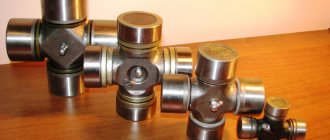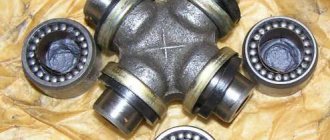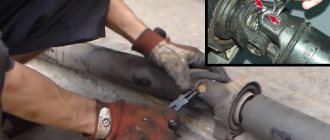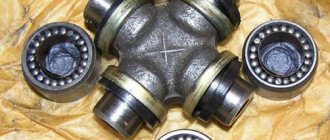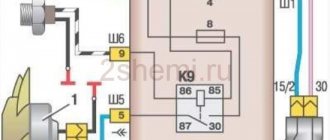When the time comes for a planned replacement of the cardan crosspiece or (more likely) vibration, beating, noise and crackling begin in the area of the cardan, car owners are prepared to pay a significant amount for repairing the cardan. Most often the cardan crosspiece requires replacement. This part cannot be restored, it can only be replaced. It is not expensive, but replacement work will require removing the cardan, so be prepared to spend a whole day at the service station. If you are not afraid of difficulties, then you can change the cardan cross with your own hands.
The cardan serves to connect the gearbox and the rear (in a rear-wheel drive car) or front (in all-wheel drive) axle. Its task is to transmit rotation from the engine to the bridge or bridges. The connection point for these elements is the hinge, the main part of which is the cross. It has the shape of a cross, at the ends of which there are cups with needle bearings. The bearing is separated from the housing by a sealing ring made of rubber or plastic. For each car model, the dimensions of the crosspieces differ from each other.
Possible crosspiece malfunctions:
- Cross play
- Needle bearing wear
- Wear of the cross itself
- Leakage and lack of lubrication
- O-ring failure
- Metallic ringing when moving
- Noise and crackling in the cardan area
Theoretically, the crosspiece is a very reliable part, the service life of which should be about 500,000 kilometers. But in practice, replacing the universal joint cross occurs after a mileage of 50-100 thousand kilometers. This is influenced by factors such as operating conditions, the manufacturer of the part, and the quality of the materials used in the manufacture of the part. If your car is often used in rural areas, then dirt and various bumps will shorten the life of your cross by several times. A common reason for crosspiece failure is simple inattention during routine maintenance. Often, no attention is paid to the lack of lubrication until the crosspiece makes itself known by vibration, noise or ringing.
What is a universal joint?
The crosspiece is made in the form of a hinge that transmits torque in a constantly changing position while the machine is moving. In addition to its main purpose - transmitting rotation to shafts that operate at angles to each other, it helps dampen dynamic vibrations. The device consists of:
- the cross itself;
- o-ring;
- oil seal;
- needle bearing;
- bearing caps;
- retaining ring.
Important! If it is serviceable, it has a housing through which the needle bearings are lubricated. Fixation is carried out using punching; the connection is considered non-separable and can be disassembled with difficulty or with locking rings.
Troubleshooting
Before carrying out repairs, you need to find the cause of the problem. To do this, you will need to drive the car onto a pit or a lift. We put the transmission in neutral and climb under the car. We inspect the cardan, special attention should be paid to the condition of the crosspiece seals. Next, holding the crosspiece, we rotate the cardan itself. If the crosspiece requires replacement, the play can be noticed immediately. If there is no play, but various noises and squeaks are heard during rotation, then the crosspiece may not need to be changed. You just need to replace the lubricant. There are two crosspieces in the cardan and both need to be diagnosed. The rear universal joint crosspiece fails most quickly, since it bears heavy loads. When moving, dirt and moisture also fall more onto the rear crosspiece.
This is interesting: Toyota 1KZ TE diesel engines
What is the propeller shaft made of?
Although, at first glance, the driveshaft seems to be a simple element, a pipe and a pipe, in reality its structure is a little more complicated. Let's take a closer look at this issue. The hero of our today’s article consists of the following elements:
- suspension bearing;
- sliding fork;
- fastenings;
- the driveshaft itself;
- crosspiece;
- seals.
It is very difficult to bring all existing types of cardan shafts to any one denominator. The fact is that these devices are used in a huge variety of equipment and, as a result, can have different designs.
For example, the driveshaft can be made up of several sections, or it can be single-section (this is usually found in sports cars). In the second case, the design is elementary - it’s just a steel pipe, both ends of which are crowned with cardan shaft crosspieces and tips.
If there is more than one section, then there are also more crosses - they are needed to interface shafts rotating at different angles.
Another important design detail is the driveshaft outboard bearing. It is a support for the entire structure and holds it in place without interfering with its rotation. The bearing is attached to the car body, and depending on the number of cardan sections there may be several of these parts.
In general, the cardan is a fairly reliable component of the car. It was created taking into account high loads and, as a rule, it copes with its task perfectly. The disadvantages of this unit include its rather large weight and dimensions; in addition, in rear-wheel drive and all-wheel drive cars, due to its location under the bottom, it “eats up” part of the useful space of the cabin.
So, fellow car enthusiasts, we briefly went over the main issues related to the driveshaft of a car.
How to change the crosspiece on the cardan
To repair the crosspiece, it is necessary to remove the cardan. Before you disassemble, you need to know some nuances:
- Fill the nuts with waterproofing agent to make the fasteners easier to unscrew.
- Use a chisel to mark the cardan flanges and rear axle flanges. If this is not done, vibration may occur on the cardan.
- To avoid damaging the threads of the nuts, it is advisable to use a curved spanner.
- If the cardan bolts rotate, you need to fix them with a screwdriver.
First, unscrew the four bolts on the propeller shaft, then remove the suspension bearing mount. After these procedures, we remove the cardan; it needs to be removed from the gearbox splined connection. Before removing the crosspiece, it is advisable to wrap the spline part with material to prevent sand from getting in there. Before removing the crosspiece, you need to prepare a tool: a hammer, pliers, a thick screwdriver and a round tube of suitable diameter. Clamping the shaft in a vice will make your work much easier. There are special pullers for removing crosspieces, but they are often not used even at service stations. However, many garage craftsmen are able to make such a device for themselves in 10-15 minutes. Next we get the retaining rings. Often, to remove them, you need to tap them with a hammer using a spacer. After this operation, the stoppers can be easily removed with pliers. Next, the cups are knocked out of the eyes. This is done with a hammer and the same spacer that was used when removing the retaining rings. Sometimes the cups fall out on their own; most often you will have to remove them with improvised objects.
Other types of movable joints and their combinations
One of the alternative types of movable connection for transmitting torque is the angular velocity joint, or CV joint. This connection helps to avoid uneven rotation of the connected shafts when the angle between the mating parts is more than 20 degrees - from 30 to 70.
The transmission of torque in situations of large misalignment is carried out by the intermediate shaft. It consists of an elastic coupling, a flange and a constant velocity joint. The mobility of the connection of misaligned elements in this design is ensured by an elastic coupling. It is a structure of steel liners and rubber bridges connected together. Jerks of the car transmission are damped due to the elasticity of the coupling. Cardan joints are also used in the shaft design, since there is a large misalignment between the shafts that are connected by the shaft.
The intermediate shaft is used, for example, in the design of the transmission of all-wheel drive VAZ vehicles (21213, 21214, 2131) of the Niva - Lada 4x4 families. At the same time, in cars of the current VAZ 21214 model, the universal joints of the industrial shaft are replaced with CV joints - less noisy and do not require alignment adjustment.
Preparing the lugs and forks and installing a new spider
The repair will be carried out poorly if the eyes and fork are not cleaned of dirt and rust. This is done with a metal brush or sandpaper. All internal surfaces also need to be cleaned and lubricated before installing a new cross. Do not forget about the grooves of the retaining rings; they need to be cleaned with an awl or a thin screwdriver. Next, the cups are removed from the new cross, and the cross itself is inserted between the eyes. When removing the cups, you need to make sure that the bearing needles do not fall apart. If there is no lubricant under the new cups, the part should be changed, or lubricated yourself. The cups are placed on the crosspiece, then they need to be pressed in with a hammer until the locking grooves open. The repair of the cross is completed by replacing the retaining rings.
This is interesting: How does it work?
Installing a cardan on a car
When installing the cardan, you need to follow several rules:
- All connections must be thoroughly lubricated
- Avoid getting sand and dirt on moving joints
- Check the condition of the crosspiece seals. If they are worn out, replace them
- Achieve a complete match of the marks made when removing the marks. If they do not match, there is a high probability of vibration of the cardan and you will have to do balancing
First we insert the splined part, then tighten the four bolts on the cardan. Don't forget about attaching the outboard bearing. All bolts must be tightened well, and then checked again. If the driveshaft comes loose while driving, the car may be thrown off the road.
Sometimes repairs may not be necessary, you just need to inject. If you don’t know how to syringe the crosspiece, then you will need a large syringe and special lubricant. If you can't find lubricant, use lithol. The rear crosspiece especially needs to be sprayed, since the bulk of the dirt gets there. Many crosses have a special hole for injection. They must be thoroughly cleaned of dirt before the process. You need to syringe until the lubricant begins to pour out. Be prepared that most of the grease will be on the ground. It is better to collect a new portion of lubricant, but do not collect it from the ground.
Problems, cardan failures
Not often, but it does happen that the driveshaft knocks. Such knocking noises can occur during a sharp start or when changing gears.
Causes of noise:
- The bolts securing the flanges and the transmission coupling have become loose.
- Increased clearance in the sliding spline connection.
- Large gap in the cross bearings.
Reasons for vibration of the driveshaft when driving:
- the shaft is deformed;
- the cardan is installed incorrectly;
- shafts are unbalanced;
- the bushing of the intermediate coupling flange or the ring of the centering secondary shaft of the gearbox is worn out;
- the outboard bearing has increased clearance;
- the bolted connections of the transverse support have loosened;
- large gap in needle bearings and crosspieces;
- the fork connection has become loose;
- lack of lubrication in the shaft splines.
Why does grease leak?
Connections with lubricant and seals often become depressurized and lubricant leaks out (Litol-24, etc.).
There are only two reasons:
- The spline seal is worn.
- The crosspiece bearing seal is worn.
If you hear a crunching sound in the driveshaft area, it is recommended to go to the nearest service center and carry out diagnostics, or do it yourself.
How to check your work
You can check your work immediately after replacing the crosspiece and installing the cardan on the car. The verification process includes the same manipulations as when searching for cross play. The cardan should also be inspected for oil or grease leaks. Pay special attention to the seals. The second stage of testing is testing in motion. During a test drive, you can immediately hear vibration, noise or beating of the cardan.
The job of replacing the universal joint is complete, and you did it yourself, spending money only on spare parts. In addition, you have completely removed and installed the cardan, now if any unit of the cardan fails, it will not be difficult for you to replace it.
Cardan or cross? Central or interaxial? "Automatic" or "robot"? Don't confuse the terms!
I confess that I am a categorical opponent of materials from the “educational educational program” series, since for some motorists the authority of “Uncle Vasya” from the neighboring garage is still disproportionately higher than the authority of all specialized literature published in the world and, alas, there is a reason for this. At a time when the useless Zhiguli cars flowed for years and even decades, crumbled and rotted before our eyes, only he, the almighty “Uncle Vasya,” revived them not only with his skills and power of thought, but also with the power of words. We found out where Soviet engineers got their hands on, where they needed to put this or that part and what this part was called. In short, we believed “Uncle Vasya” and absorbed all the knowledge about the car received from him without exception. Time, however, passes, and it’s time to get rid of other garage stereotypes and finally figure out why an engine is not a power unit, but... just a unit!
Are there balls in the cardan or are there just needles?
Any motorist, of course, knows such a thing as a “cardan”, also known as a “crosspiece”, also known as a “Hooke’s joint”. As you might guess, Hooke is the inventor who came up with this amazing mechanism. The Hooke joint is designed to transmit power between two shafts located at an angle to each other. Therefore, a shaft that includes at least one universal joint is called a “universal joint.” It is not surprising that this hinge has found wide application in cars, and not only in transmissions, although this design is mainly known from cars with a classic layout, where the driveshaft transmitted power from the gearbox to the rear axle. Hooke's joints are also used to transmit power to the wheel, however, mainly on heavy wheeled vehicles, although there are also “light” examples. For example, on the first generation Subaru Leone, the all-wheel drive version of which appeared in 1972, shafts with spiders were used specifically to drive the rear wheels, but today, of course, this can no longer be the case. In short, people by “cardan” specifically mean a Hooke’s joint, that is, two forks connected to each other by a cross through needle bearings.
The design of cardan joints of unequal (a, b, c) and equal (d, e) angular velocities. 1 - cover; 2 — locking plate; 3 — bearing cup; 4 - needles; 5 — oil seals; 6, 10, 24 and 28 - forks; 7 - safety valve; 8 — cross; 9 — oiler; 11 — cardan shaft; 12 - reflector; 13 — self-clamping oil seal; 14 — retaining ring; 15 and 16 — oil seals for radial and mechanical seals; 17 — inner fist; 18 — central ball; 19 — outer fist; 20 — driving balls; 21 - pin; 22 — hairpin; 23 — axle shaft; 25 and 27 — semi-cylindrical fists; 26 - central disk
Meanwhile, the well-known “grenade”, consisting of two fists and balls between them, without which almost no passenger car can do today, is also designed to transmit power between shafts located at an angle to each other. You might be surprised, but a “grenade” is also a gimbal! What is the difference between them? First, let's give the correct names of both hinges. A “crosspiece” is a “universal velocity universal joint.” “Grenade” is a “universal joint of equal angular velocities.” The difference is that at a constant speed of the grenade’s input fist, its output fist also rotates at a constant speed. At a hinge of unequal angular velocities, at a constant speed of the input fork, the output fork does not rotate uniformly, but according to a harmonic law, that is, along a sine wave or cosine wave. This can be compensated by installing a second hinge, where the input fork is rotated 90 degrees relative to the input fork of the first hinge. However, at small angles, a compensating rubber-metal coupling is often used for compensation. The “Grenade” does not impose such restrictions, however, for reasons of control of the drive wheels and their optimal location during installation and operation of the suspension, two CV joints are used. In short, both the grenade and the spider joint are classified as universal joints.
Central or interaxial?
The expression "center differential" is slowly falling out of use, since only a few cars with full-time all-wheel drive continue to have engineers place a differential in the transfer case. However, while this term is in use, it would be good to understand it, since the word “central” does not give the slightest idea about that mythical “center” where this mechanism with two degrees of freedom seems to be located.
The term “central differential” entered the Russian language solely at the suggestion of journalists who, without any adaptation, translated the expression read in the foreign English-language press. To remember where it all came from, let's move to 1970, when the British introduced the Land Rover Range Rover to the market - the world's first frame SUV with permanent all-wheel drive, for which a center differential located in the transfer case was responsible. At first, the Rover Company called it a "third differential" - in the sense that the first two distribute power between the right and left front wheels and between the right and left rear wheels.
Chassis and “X-ray” view of the Land Rover Range Rover: the “third” differential is located in the transfer case, interlocked with the gearbox
Transfer case Land Rover Range Rover: readers, even superficially familiar with the structure of the car, will easily find in this beautiful three-dimensional “section” the center differential, which the company then called the “third”
In August 1979, the American American Motors Corporation introduced the world's first mass-produced passenger car with permanent all-wheel drive (we do not count the Jensen SV-8 and Jensen FF, produced in small series in the 60s). A little later, a mechanism for disabling the front wheels was introduced into the design. Here, the transfer case also had a differential, which, however, is not given a name either in the press release or in the consumer brochure - the compilers only write about “automatic all-wheel drive that reads road conditions.” The free differential in the transfer case was blocked by a viscous coupling, and all the “automaticity” refers to it.
AMC Eagle transmission diagram (using the station wagon version as an example). As you can see, here the “central” differential is not located in the center at all...
In March of the following year, at the Geneva Motor Show, Audi NSU Auto Union AG, from which, frankly, no breakthroughs were expected, showed an Audi quattro car. In the consumer brochure, the “third” differential was called “center differential”, but this meant “dividing”, that is, dividing the power flow into two. In this case, translating “center differential” as “central differential” is the same as General Motors as “general motors,” which is what they did in Soviet times in the magazine “Behind the Wheel.” Actually, in presentations and releases the company used the expression “interaxle differential”, which was adopted by disciplined English-speaking journalists. What about the native German press? The leading global automotive publication, auto motor und sport, to this day, adopted the terms “Zwischendifferenzial” and “Mitteldifferenzial”, that is, “intermediate differential” and “dividing, median,” respectively.
Schematic representation of the Audi quattro and the transfer case, also far from the “center”
Meanwhile, in the process of natural replacement, the English press almost completely switched to “center differential” at the end of the 80s, and the German press to “Zentraldifferenzial”. What do we have? But here, as we said, journalists, without bothering to delve into the essence of the issue, simply designated the “center” differential as “central”. This is incorrect, so we urge you to say it correctly - “interaxial”.
Where is torque and where is power?
Let's take a break from the hardware. You, of course, noticed that when talking about cardan joints and differentials, we always talk about power transmission and power flow distribution, and not about torque transmission and its distribution, although we are accustomed to expressions like “the differential distributes torque between the axles in the ratio 40:60.” This can happen only in extremely rare cases, which usually ends in breakdown, as discussed below. Let’s try with our fingers, without diving into formulas, to understand how power differs from torque, and ask readers with engineering training and weak nerves to skip this paragraph. So, let’s remember the main thing: “power” is something that does not exist in nature, something that cannot be “touched”, it is a phenomenon that has no applied support. Power was invented by engineers solely to facilitate calculations - this category has no other meaning. When applied to automotive matters, power is understood as a combination of engine torque and crankshaft speed. In a very simplified way, we can say that power is “effort in motion.” Thus, torque is one of the components of power.
The relationship between torque, engine crankshaft speed and power is best illustrated by the external speed characteristics of the engine. The picture shows the VSH of an 8-cylinder Audi engine with a displacement of 3993 cc. cm, which shows a maximum torque of 650 Nm in the range from 1700 to 5500 rpm. Maximum power of 382 kW (520 hp) occurs at 6000 rpm
In turn, both torque and rotation are the most real natural quantities. We can easily imagine rotation through the number of revolutions per unit of time. For example, the speed of the minute hand of a clock is one revolution per hour, and the speed of the second hand is one revolution per minute. We can also measure torque with a dynamometer. Let us remember that this is the force multiplied by the shoulder of its application, that is, a newton meter. Force, as we remember from school years, is the product of mass and the acceleration of gravity. Now let's return to the question: can, for example, a driveshaft transmit torque from the gearbox to the drive gear of the axle's main drive without transmitting power? Oddly enough, yes, but such situations in car operation are very rare and short-lived. For example, it’s spring. There was a thaw during the day, and the car owner parked the car so that the drive wheels were in a puddle. At night there was frost and the wheels were frozen in ice, which the driver absent-mindedly did not notice in the morning. He gets into the car, turns on the ignition, depresses the clutch, starts the engine, engages the gear (if the gearbox was in neutral) and releases the clutch pedal. If the ice is strong, the engine will stall in a second; if not, the engine will have enough strength to tear off the wheels. So here it is. In those fractions of a second, when the engaged clutch has not yet begun to slip, the driveshaft (and in general the entire transmission) really only transmits torque to the wheels: there is force, but there is no rotation.
Is an engine not a power unit?
No no and one more time no. An engine can be called by the general term “unit,” although “engine” has many official definitions. For example, the special literature of Soviet times meant by an engine “an energy-power machine that converts any type of energy into mechanical work.” In the current Technical Regulations of the Customs Union “On the safety of wheeled vehicles,” we find only an “internal combustion engine,” that is, “a heat engine in which the chemical energy of the fuel burning in the working cavity is converted into mechanical work.” But if you like the word “power” so much, then a car engine can also be called a “power unit”: technical regulations mean by it “internal combustion engine”, “combined power unit of a hybrid vehicle” or “electric motor”.
The VW Transporter power unit was not always installed at the front, as it is now - for a long time the engine was located in the rear overhang, and the gearbox was in the base
At one time, the layout with a spaced power unit was used not only on sports cars, but also on ordinary city sedans, like this Alfa Romeo Alfetta, which had the engine in the front and the gearbox located at the rear axle
What is a “power unit”? Again, Soviet special regulatory literature meant by this “engine, clutch and gearbox”, and the current national standard of the Russian Federation “Wheeled vehicles. Terms and definitions" - "a structure formed by an engine and transmission units rigidly connected to it." As you can see, this term is somewhat expanded; let’s say, cardan shafts can also be included here, which, of course, is unnecessary. What about abroad? The German DIN standard proposed the following interpretation of the term “power unit” - “engine, clutch (if equipped), gearbox and cooling system.” But why is the cooling system considered a separate, self-sufficient element of the power unit? This is how it happened historically. The fact is that during the formation of European standards, that is, in the post-war period, there were many cars on the market where the engine was cooled not by liquid, but by air, so with the advent of a separate system, it was separated as part of the power unit. In short, an “engine” is not a “power unit.”
Is “automatic” a “robot”?
In this question, which is actually very simple, we will start from the stove, that is, from the scientific discipline called “The Theory of Automatic Control”. All technical students are usually introduced to its elements, starting with the simplest automatic device, which is almost 250 years old - the Watt regulator, which operates according to the proportional law. We, of course, will not dive into the principle of operation of automatic mechanisms, but will focus on terminology, and immediately - as applied to gearboxes. So, “automatic” is a box where the driver does not select a gear and does not engage it. In turn, “manual” is called a box where the driver selects a stage and turns it on, moving the lever to the desired position and thus using a mechanical system of rods and levers.
Simply put, to distinguish an automatic transmission from a manual one (we usually call such designs mechanical), you do not need to open the hood, but look into the interior and look at the pedal assembly. If there are three pedals, then the car has a manual transmission; if there is no clutch pedal and there are only two pedals - gas and brake, then know that you are getting into a car with an automatic transmission. The design of “automata”, and especially in terms of control, can be different - this is a topic for a separate material, but today we want to focus on “robots”. About 20 years ago, with the widespread use of single-clutch transmissions, the public for some reason began to distinguish “robots” as a special type of mechanism, which intensified with the spread of transmissions with two automatic clutches, which are collectively called “double clutch transmission” (DCT). ) or the most popular - “direct shift gearbox”, which was introduced by Volkswagen.
An automatic transmission with two clutches, like all modern automatic transmissions, with rare exceptions, in addition to operating in the basic mode without driver intervention, also offers a semi-automatic mode, when the driver selects a gear (using the steering wheel paddles or selector), and the actuator turns it on
Meanwhile, the “robot” is exactly the same “automatic”, which is easy to verify by counting the pedals on a car with DCT (DSG): the driver does not select a stage and does not turn it on. Once again, journalists are to blame for the distinction between “robots” and “automatic machines”, who, without understanding it, directly translated the word “robotized” from the foreign press, despite the fact that a hydromechanical “automatic” gearbox with a torque converter and a planetary gearbox is no less “robotic” than DCT/DSG.
And for today we are done with the educational program. If you liked it, write in the comments which direction we should turn in, which knots to talk about and which stereotypes to dispel, and perhaps, on the contrary, strengthen.
